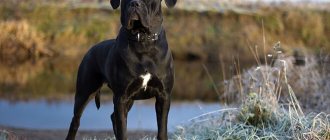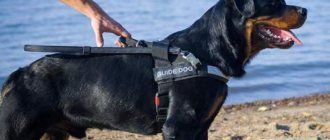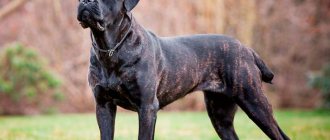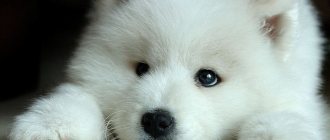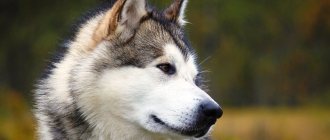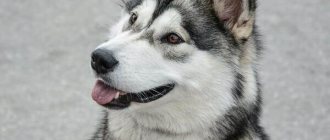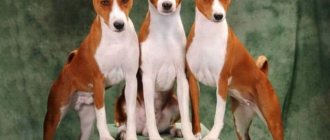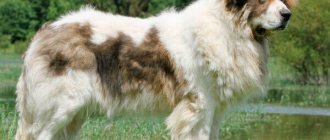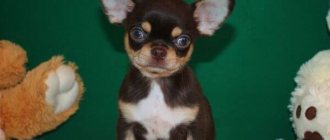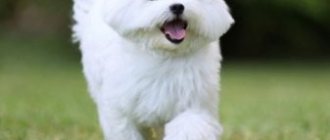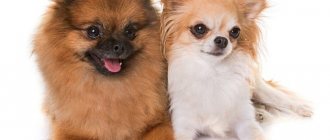There are no bad dog breeds - there are breeds that are not suitable for you. This is the main thing you need to learn before you start choosing a puppy. In order to understand who might be right for you, you should make a list of the breeds you like and study the characteristics of each of them. I’ll tell you about the miniature schnauzer - the breed that I chose, although it wasn’t even on the original list. Without concealment, I will name its advantages and disadvantages, advantages and disadvantages.
A miniature schnauzer named Chester is my first dog, and I am very glad that I chose this breed. After all, the wrong breed can discourage you from having dogs for the rest of your life. And I could do it, because... At first I liked completely different ones. I wanted a shepherd dog, a St. Bernard, a basset hound, a chow chow, a husky, a beagle, a Doberman and other big and not so big, sometimes simple, sometimes too complex dogs. After reading their descriptions, I realized that in terms of content and character they were not suitable for me. Sheepdogs and St. Bernards are too large and often shed heavily and also smell like dog. Chow Chows are stubborn and not as trainable as I would like. Huskies and Dobermans are stubborn and dominant, but I didn’t want to live and strain myself, posing as an alpha female: I don’t like that, I’m more suited to animals that I can love and not think that because of this they might respect me less and disobey.
Article continues after advertisement
In general, I found incriminating evidence for all the breeds that I liked, after which I didn’t want to get involved with them. I'm not trying to say they are bad. They just didn’t suit me specifically, or didn’t fit the conditions that I’m ready to offer them: a city apartment, my husband and I are moderately active, the desire to travel with the dog around the world, the reluctance to smell the strong smell of a dog and endlessly remove the hair that falls out. Adding to all the difficulties was the presence of a cat, i.e. it was necessary to take a breed that is friendly towards cats and does not cause damage to them during games.
In addition, the dog had a number of requirements: sociability, kindness, courage, stable psyche, positivity, good trainability. And I found such a breed - these are schnauzers, in particular, miniature schnauzers.
Well, now I’ll tell you about all their advantages and disadvantages in order. I will do this using my dog as an example - it seems to me that he is a bright and typical representative of a good breed type in all criteria: appearance, intelligence, psyche.
Breed traits
Breed traits (on a 5-point scale)
| Miniature Schnauzer (Dwarf Schnauzer) | |||
| Activity | in the house | 3.2 | |
| on the street | 3.6 | ||
| Obedience | training | 3.6 | |
| strangers | 4.1 | ||
| Domination | in family | 2.3 | |
| over dogs | 2.9 | ||
| Defending your territory | from people | 3 | |
| from dogs | 3.4 | ||
| Sociability | in family | 4.5 | |
| with strangers | 3.4 | ||
| with dogs | 3.1 | ||
| Concentration | in family | 1.6 | |
| in front of strangers | 2 | ||
| with dogs | 2.1 | ||
| Aggressiveness | in family | 1.3 | |
| to strangers | 2 | ||
| to the dogs | 2.5 | ||
| to cats | 2.8 | ||
| Family behavior | calmness | 4.1 | |
| demand for affection | 4.1 | ||
| excitability | 4.1 | ||
| playfulness | 4.1 | ||
| excessive barking | 3.1 | ||
| behavioral breakdowns | 2.1 | ||
| Tolerance for children | up to 4 years | 3.3 | |
| over 4 years old | 3.8 | ||
| Institutional use | watchman | 4.2 | |
| bodyguard | 2.2 | ||
This breed is often compared to the following dog breeds: Jack Russell Terrier, West Highland White Terrier, Miniature Pinscher, Miniature Schnauzer, Yorkshire Terrier.
Photos of miniature schnauzers will help you understand what they look like:
Health
Miniatures live on average 12-15 years. If the miniature schnauzer is properly cared for, the dog will be active until a very old age. Representatives of the breed are prone to the following diseases:
- Food allergies;
- Atopic dermatitis;
- The presence of comedones on the back;
- Cataracts that appear at any age. In severe cases, glaucoma develops;
- Retinal degeneration (occurs as you get older). The dog may become partially or completely blind;
Blindness in a Miniature Schnauzer
- Urolithiasis disease. More often occurs due to the consumption of low-quality food and heredity;
- Pulmonary artery stenosis. Genetic pathology;
- Heart rhythm disturbances;
- Hypothyroidism. Hormone deficiency, malfunction of the thyroid gland;
- Diabetes. Similar to hypothyroidism, it provokes disorders in the thyroid gland;
- Damage to the pancreas;
- Lipoma. Tumor in adipose tissue;
- Oncological diseases;
Unfortunately, it is impossible to predict the development of cancer in a puppy in advance.
- Malignant tumor in the testicles. More often observed in unneutered dogs;
- Epilepsy. It makes itself felt at 4-5 years. The attacks are spontaneous. You can read about the symptoms of primary and secondary epilepsy in dogs on our portal;
- Cryptorchidism. An anomaly characterized by non-descent of the testicle into the scrotum. With a process like this, any male dog is considered rejected.
General characteristics of the breed
The Miniature Schnauzer is a breed developed in Germany. The name is associated with the features of appearance: zwerg - “gnome, dwarf”, schnauzer - “mustachioed muzzle”. At first, representatives of the breed were called wire-haired pinschers, then - dwarf schnauzers. These dogs perfectly combine small size and good working qualities.
This is the smallest service dog. Thanks to their fearlessness, intelligence and self-confidence, they are excellent guards and watchmen. They serve as border guards, work at customs, and in the police. An excellent sense of smell and developed intuition allows them to be used to search for drugs and explosives.
But lately, miniatures have become companions and pets. These are dogs with developed intelligence, affection for the owner, constant optimism and increased sensitivity. They are extroverts by temperament - always cheerful and energetic. You will never be bored with such a pet; he is ready to accompany his owner everywhere, wants to participate in all activities and loves adventures.
They say about miniature schnauzers that they are “a small dog with a big heart.” They can feel the mood and can help a person with depression. They are artistic and have a sense of humor. With its antics and funny appearance, this pet amuses its owners all day long.
| Options | Characteristic |
| breed name | miniature schnauzer, miniature schnauzer, miniature schnauzer |
| group of breeds according to the ICF classification | pinschers and schnauzers |
| country of origin | Germany |
| life expectancy | 12-15 years |
| height | male 32-36 cm, female 28-34 cm |
| weight | male 5-8.2 kg, female 4.5-6.8 kg |
| working qualities | watchdog, guard, shepherd, rat catcher |
| friendliness | affectionate, good with children |
| attitude towards loneliness | does not tolerate well |
| activity | energetic, nimble, love to run and jump |
| intelligence | very smart, quick-witted |
| ability to train | easy to train |
| complexity of content | sheds little, but coat care is difficult, requires haircut and trimming |
| noise | react to any rustle by barking |
| health | good |
pros
Due to its small size, a miniature schnauzer can be kept in a city apartment, even a small one. These dogs are suitable for athletic young people and active retirees, families with children and single people. The dog can become an excellent companion to any owner who will pay enough attention to him. The popularity of the breed is also explained by the fact that its representatives have the following advantages:
- fearless, vigilant, always ready to rush to the owner’s defense;
- have a stable psyche;
- smart, in terms of intelligence they are in 12th place in the ranking of all breeds;
- sociable, friendly;
- cheerful, cheerful;
- artistic, have a sense of humor and athletic ability;
- attached to the owner, devoted, faithful;
- get along well with all family members, patient with children;
- they shed little, are not allergic;
- clean, no dog smell;
- get along well with cats and other pets;
- active, but do not need long walks;
- adapt to the owner, are not intrusive, know how to empathize;
- With good care they live long and remain active.
Minuses
But the Miniature Schnauzer is not a dog for everyone. It should not be purchased by a person who leads a sedentary lifestyle or works a lot. This pet requires attention and is difficult to maintain and train. Therefore, before getting a dog of this breed, you need to study its disadvantages.
- Difficult coat care. Regular visits to the groomer or self-cutting and trimming are required.
- Very active and playful. During a walk they will not walk calmly, they need to run and jump. They may begin to chase a bird or small animal, so it is advisable to walk on a leash.
- They are cocky and rush into fights with dogs, even big ones. If not properly socialized, they can be aggressive with other animals.
- They love to be cunning, manipulate the owner, misbehave, and shirk commands. They find an approach to any person, achieve everything they want, and can be stubborn.
- They are aggressive with strangers.
- They need constant intellectual and physical activities and a large number of toys. If the miniature gets bored, it will become hot-tempered and disobedient. The owner of this dog must pay a lot of attention to it.
An interesting video will complement the information about the pros and cons of the Miniature Schnauzer breed:
Video: Pros and cons of the Miniature Schnauzer breed
Video: Miniature Schnauzer dog: pros and cons of the breed
Possible diseases
Miniatures have excellent health, but still some troubles should be anticipated.
- Eye disease is most likely to occur, usually in aging dogs. Therefore, it is worth regularly wiping your eyes, removing secretions and preventing the formation of crusts.
- There are known cases of allergic reactions to a sudden change in diet or an unsuitable product. The irritant should definitely be identified, and changes in diet should be made gradually.
- Inflammations on the skin may also appear, in particular after trimming.
In any case, if your pet has become even a little lethargic or refuses to go for a walk, this is a reason to immediately contact a veterinarian.
Origin story
In Germany, since ancient times, in the Middle Ages, wire-haired dogs - schnauzers - were kept to guard homes and protect crops from rodents. Some researchers believe that they have common ancestors with German Pinschers. They were identified as a separate breed due to their appearance. After the appearance of miniature and large individuals in the 19th century, it began to be called the miniature schnauzer. From her came the Giant Schnauzers - Giant Schnauzers and Miniature Schnauzers - Dwarf Schnauzers.
To breed a miniature variety, the smallest representatives of the miniature schnauzers were crossed with poodles, Spitz dogs, afferpinschers, and miniature pinschers. White and spotted individuals were excluded from breeding; breeders sought to achieve uniformity of colors: black and silver.
The breed was registered in 1888. These dogs began to be used to guard herds, farms, and catch rats. Miniature dogs could crawl into rodent holes. Interest in the breed increased after the First World War. Now she is one of the TOP 20 most popular dogs in the world.
Miniature schnauzers appeared in Russia only at the end of the 20th century. They were brought from Czechoslovakia. At first, these dogs were used for service purposes - they worked with border guards. Breeding work began in the 80s in Moscow.
Mating
An adult male can fertilize 40 females in a year . But pregnancy should not be frequent. It is advised to take a year's break between the birth of puppies. Dogs become sexually mature at six months. Then the bitch's first heat begins. But at this age, dogs are still too small and not formed to bear offspring.
The most favorable time is the third heat, or rather, 13-15 days from its beginning. Usually, it comes at 20-25 months . Males are advised to untie later: at 30-35 months . In order for breeding dogs to give birth to registered puppies, mating is carried out through a club or kennel. There, owners receive a certificate for mating and fill out a form.
For the first time, it is better to invite a specialist who will help the owners understand the essence of the process. Helping animals is simple: the girl is held under the stomach and by the head, the boy is directed into the noose. If pets lose their balance, pillows are placed on them.
On the appointed day, the bitch is brought to the dog, where he will feel relaxed. The girl needs to be calmed down and stroked. She will allow you to do the cage only if she is not scared or angry. Sexual intercourse takes 10-15 minutes. There must be a lock at the end. If it was not there, then the mating is repeated after 24 hours.
Read a detailed article on the topic: “Everything you need to know about breeding dogs: appropriate age, what to do if it doesn’t work out, rules and tips.”
Description of the appearance of representatives of the Miniature Schnauzer breed
The Miniature Schnauzer breed standard was adopted in 1890. It has been adjusted many times, but the main features have remained unchanged. The Miniature Schnauzer is a miniature standard schnauzer with no signs of dwarfism. The build is graceful, but it is a strong, muscular dog of a square format. On average, the weight of a miniature schnauzer should be 4-8 kg, height 30-35 cm.
Features of the miniature's appearance: coarse fur, expressive muzzle with long mustache, beard, frowning eyebrows and bangs, proud posture, square body with splayed hind legs. The stern expression of the muzzle, combined with its short stature, makes the dog's appearance funny.
Head
The skull is strong, proportional in size to the body, the occipital protuberance is poorly defined. The head gradually tapers from the ears to the nose and has the shape of a blunt wedge. Because of the thick whiskers sticking out to the sides, the muzzle appears square. The forehead is flat, the stop is not sharp, but is emphasized by shaggy eyebrows.
The nose of a miniature schnauzer has large nostrils and is black. The lips are tight fitting and dark. The jaws are strong, with large teeth. Scissor bite. The ears are triangular and set high. The tips hang down and touch the cheeks. Previously, the ears were cropped, in which case they should stand up and point to the sides. The eyes are small and oval. The color is dark, the look is curious. The eyelids fit tightly.
Body and tail
The neck is of medium length, muscular, without folds. The withers are well defined. The front part of the body is higher, the line of the back descends to the croup, smooth. The loin is short, the chest is wide and powerful, the stomach is tucked. The build is compact, square in shape.
The tail is set high and raised up. It has a crescent shape. Previously it was cropped, but now it remains natural according to the standard.
Limbs
The forelimbs are straight, wide, set parallel and close to each other. The elbows do not protrude, the shoulders are long, the shoulder blades are set obliquely. The hind limbs are set back slightly, the legs are long, and the thighs are muscular. The paws are round, reminiscent of a cat's. The toes are short, with hard pads, and the claws are black. Movements are free, sweeping, springy. These dogs run quickly, but elegantly, and push off strongly with their hind legs.
Miniature Schnauzer coat and colors
The coat and undercoat are thick, dense, and lie close to the body. The hairs are wiry, hard, and of medium length. On the head, neck and shoulders the fur is smooth and shiny, on the limbs it is softer. Should not be tousled or wavy. The face has a well-defined beard, mustache and eyebrows.
At first, miniatures were bred in only two colors: “pepper and salt” and black. In 1977, another color scheme was recognized: black and silver. Now she is the most popular in the whole world.
In the early 90s, the International Canine Federation approved another variety of miniature schnauzers - white. It is not recognized in some countries and the dogs are considered albinos. White puppies are obtained from salt and pepper dogs. Chocolate-colored miniature schnauzers were also popular in Russia. But since 2011, such dogs are not allowed for breeding. They have a brown nose and light eyes.
According to the standard, dogs of this breed can have one of four colors:
- miniature schnauzers of the “pepper and salt” color look dark gray or silver, this color is obtained due to the even distribution of black and white hairs, a dark mask is required on the muzzle;
- pure black, without brown color or other impurities;
- black with silver – most of the body is dark, light areas on the muzzle, chest, limbs;
- White dogs look beautiful.
Disqualifying faults
In order for a dog to be admitted to exhibitions and breeding, its appearance must meet the standard. A miniature schnauzer can be disqualified for the following shortcomings:
- massive or round head;
- short or too elongated muzzle;
- the skin does not fit, gathers in folds;
- light eyes;
- curved back line;
- soft wavy wool;
- short limbs;
- sparse teeth, malocclusion;
- deviations in height from the norm by 1 cm or more.
The photo complements the description of the appearance of the representatives of the breed:
Cupping
The procedure of tail amputation and ear cropping has been considered controversial in the global canine community in recent decades. In a number of countries, docking of ears and tails is prohibited as such, which is why modern international standards gravitate towards the natural undocked appearance of animals. The same applies to miniature schnauzers. Their show appearance is with naturally shaped ears and a tail. But, as experienced dog breeders point out, in countries where docking is not prohibited, unscrupulous breeders can thus hide defects in the corresponding body parts of puppies.
Character of Miniature Schnauzer dogs
Miniature Schnauzers differ from Giant Schnauzers only in size. This dog has a lot of courage and love in his small body. She has lightning-fast reactions, strong and fast. This is a vigilant, selfless pet, ready to protect the owner and his property. He has a stable psyche, an active temperament and a cheerful disposition.
Miniature Schnauzers get along well with children, love them very much, and are patient with various tricks. They participate in all games and guard. This dog can become not only a child’s best friend and companion, but also a protector.
Each miniature has its own character traits, but there are common breed characteristics:
- goodwill;
- devotion;
- optimism;
- resourcefulness;
- sociability;
- friendliness;
- energy;
- alertness;
- intelligence;
- developed intuition.
These dogs should not be aggressive, suspicious or cowardly. Disadvantages include irritability and anger.
The photographs show how miniature schnauzers behave:
Education and training
This dog needs serious education and training. It is necessary to teach your dog to control his active temperament from an early age. Without proper upbringing and socialization, miniatures are prone to aggression and are ready to fight with any opponent. Therefore, it is so important to achieve unquestioning submission and obedience. But this is not easy to do, despite the fact that they are smart and quick-witted animals.
Miniature Schnauzers are very cunning, stubborn dogs, capable of manipulation. Therefore, education must be consistent, strict and constant.
From an early age, the miniature dog needs to be taught the rules of behavior in the home and in society. The puppy needs to be made to understand who is in charge. It is important to immediately wean off biting, barking for no reason, and gnawing on things. It is necessary to strictly suppress unwanted behavior, but without rudeness. It is better to try to distract your pet; he should have a lot of toys. As punishment, you can scold the dog in a stern voice or, as a last resort, lightly shake the dog by the scruff of the neck without causing pain. Reward should be affection, praise or a treat.
When training a miniature dog, you need to take into account that these dogs love to learn, perform various tricks, and solve problems. But they do not tolerate monotony. Commands that are repeated many times may become unexecutable due to boredom. They will become cunning and shirk training. Therefore, they need to be carried out in a playful way.
Basic training should last up to six months. Adult miniatures are less amenable to training. From an early age you need to accustom your pet to a name and a leash. He must get used to washing his paws and patiently enduring hygiene procedures and trimming. More serious classes and training begin after 6 months, you can use the help of a dog handler. It is important to teach your pet the following commands:
- place;
- to me;
- near;
- stand;
- walk;
- sit;
- lie;
- it is forbidden;
- aport.
Miniatures perfectly understand voice intonations, gestures, and are capable of imitation. They require rigor, love and attention. But the main thing is to achieve complete trust and close contact; the owner must be an authority for the dog. With the right approach, this dog is easy to train. Then the adult dog will be obedient and non-aggressive. The miniature can also be taught circus tricks. They enjoy participating in agility, freestyle and other dog sports.
Video about the features of raising and training miniature schnauzers:
Video: Stubborn Miniature Schnauzer
Video: Training a Miniature Schnauzer puppy. Result after 5 lessons
Video: Miniature Schnauzer at work
What you need to know
Before starting to work on the character of his pet, the owner needs to find out what qualities a puppy must have in order to be called well-mannered and obedient. The processes of training and education have a close relationship. Training includes learning to unquestioningly carry out simple commands. You can start it immediately as soon as the puppy appears in the house (regardless of its age) and the equipment and necessary things have been purchased for it. Education involves the formation of a clear hierarchy in the family, an understanding of what the owner’s behavior should be towards the dog.
We cannot ignore everything that a well-mannered puppy and its owners should know:
- If owners want to solve difficulties associated with their pet’s behavior, they must learn the main rules of upbringing. Failure to comply with these principles becomes the main reason for their appearance.
- One of the most important skills for a pet is toilet training outside or in a certain place in the house. The puppy will not be able to deal with these issues on his own. He can acquire this skill only through training. You need to start developing good toilet habits as early as possible. And the more correct the chosen training tactics, the faster you will be able to achieve stable results.
- You need to train your pet from the moment it starts living in your home. At a minimum, he should learn and follow basic commands.
- Puppy owners can face many difficult situations. For example, if a baby fawns over strangers, they begin to fear that he will not be able to become a reliable protector. Or, perhaps, the puppy bites when trying to feed and during play. Other pets may pick up crap from the floor or flatly refuse to listen to you. If you pay attention to different aspects of education, you can solve such problems.
Maintenance and care
When starting a miniature dog, you need to study the characteristics of its character and temperament. This pet needs to be kept in the house, it is not a yard dog. Before the puppy arrives, you need to be well prepared: remove all objects that the dog can chew, drag away or break. It is advisable to hide wires and shoes. It should be taken into account that these dogs are curious and are able to penetrate the most inaccessible places.
It is advisable to walk your pet three times a day. They need physical activity and new experiences. This dog will not go to the litter box like other miniature dogs. Without proper walking, he will begin to spoil things, may become depressed, become aggressive and disobedient.
In the city, it is better to take your miniature dog outside on a leash. It is recommended to take him to the dog playground, where you can play ball and do some training. In winter, after trimming, your pet needs to be walked in warm overalls, as the skin becomes sensitive.
Caring for miniature schnauzers is not very easy. In addition to the usual hygiene procedures for all dogs, they need to be regularly cut and trimmed. This can be done at home, but if the dog participates in exhibitions, you will have to visit a hairdresser. The haircut requirements for representatives of this breed depend on the color.
Apart from grooming, other procedures are simple:
- it is enough to bathe completely 2-3 times a year, these dogs are clean and do not emit a dog smell;
- wipe your eyes every day with a cotton pad moistened with boiled water;
- Ears need to be inspected regularly and cleaned of dirt weekly;
- if the dog doesn’t walk on asphalt a lot, it is necessary to shorten the claws;
- Brush your teeth once a week with a special paste and give chewing bones to prevent plaque.
Miniature Schnauzer coat care
It is recommended to visit a groomer every 3 months. In this case, caring for the dog consists of maintaining the beauty of the fur on the face, paws, and belly. Many owners trim their miniature schnauzer themselves. To do this you will have to buy special tools and cosmetics. Trimming is necessary, since dead fur does not fall out on its own during shedding; it must be removed.
Miniature Schnauzers also require regular grooming. Completely - 2-3 times a year and every month - cosmetic. Long hair is difficult to care for: it gets tangled and tangles form. This dog looks untidy.
Proper care for the coat of a dog of this breed includes:
- trimming every 3-5 months;
- every month cosmetic haircut of the head - formation of the correct shape of the beard, mustache, eyebrows;
- Regular trimming of the hair between the toes and under the tail is required;
- plucking hair from the ears every 1-2 months;
- brushing the undercoat a couple of times a week;
- daily care of the beard, belly and paws: washing, combing, picking up garbage, conditioning.
Video about the features of grooming:
Video: Miniature Schnauzer puppy. Rules of care. Contents, grooming.
Video: Grooming a miniature schnauzer, caring for the coat of a miniature schnauzer.
Nutrition
Miniature Schnauzer puppies are fed 4 times a day until 4-5 months, then 3 times. An adult dog needs two meals a day. It is not advisable to overfeed miniatures. Although they are not prone to obesity with sufficient physical activity, they may become overweight. You cannot give a lot of treats, pieces between feedings, or food from the human table. Sweets, smoked foods, sausages, baked goods, processed foods, legumes, salty and spicy foods, and pork are prohibited.
The basis of a miniature schnauzer's diet should be meat. Chicken, beef, and offal are allowed. The meat is mixed with porridge: oatmeal, buckwheat, rice. Once a week, your pet should be given boiled boneless sea fish, chicken egg yolk, and cottage cheese. Vegetables, seasonal local fruits, and fermented milk products are useful.
Many Miniature Schnauzer owners choose ready-made food. While eating, these dogs get their mustaches and beards very dirty; their faces need to be washed every time. Feeding with industrial food will make it easier to care for. Just don’t mix it with natural products. The animal must have clean water freely available.
It is recommended to choose premium and super-premium food. They should be designed for active small breed dogs. This could be Royal Canin, Purina One, Arden Grange, Brit. Such food contains all the nutrients, vitamins, and sufficient amounts of protein necessary for the miniature’s health.
Health
Pedigree miniature schnauzers purchased from well-known nurseries are in good health. Individuals with hereditary diseases are not allowed to breed. Therefore, diseases in these dogs are rare. They usually develop with old age or with improper maintenance. Miniatures may be prone to the following pathologies:
- glaucoma, cataract;
- inflammation of the ears;
- allergy;
- epilepsy;
- hypothyroidism;
- diabetes;
- liver diseases;
- sensitive digestion;
- tumors;
- urolithiasis disease;
- hair loss;
- acne.
The pet must be regularly treated for external parasites and given anthelmintic drugs. To protect against infections, you need to get all the vaccinations recommended by your veterinarian every year. With proper care and good heredity, a miniature can live 14-16 years.
Tatyana, 27 years old
My husband and I decided to get a dog and spent a long time choosing a breed. We wanted the dog to be small, since we live in an apartment, and at the same time not like a “sofa plush toy.” After consulting with a dog handler, we purchased a Miniature Schnauzer. This is truly a wonderful dog! Our Maurice is a true gentleman. She always accompanies me on my morning runs and behaves well in the city when we go out to meet my husband from work in the evening.
Maurice and I are always the center of attention, because our guy is just handsome! Grooming is not difficult - we visit the salon 2 times a month, where they do professional grooming. Maurice is always neatly trimmed and combed. We feed exclusively Royal Canin mini adult, as recommended by our favorite website https://melkiesobaki.com/ and there are no problems with nutrition.
Maurice tends to chase cats, but we try to stop this negative habit, and he listens. My husband and I are thinking about getting a mate for our male dog, as we have now become true connoisseurs of the breed.
How to choose a miniature schnauzer puppy
To be sure of the absence of hereditary pathologies and compliance with the breed characteristics, buy a puppy from a well-known kennel that specializes in such dogs. The breeder needs to study the conditions of keeping the animals, the behavior of the mother, the presence of all vaccinations and documents required by age.
Puppies of this breed are sold from 1.5-2 months. But if you are buying a dog to participate in exhibitions, it is better to take a 6-month-old dog. Only from this age do all breed characteristics and defects appear. But it is not recommended to purchase an adult dog - miniature dogs do not get used to new owners well, and it will be impossible to re-educate such a dog.
A healthy purebred puppy should have the following characteristics:
- active, curious, playful;
- no signs of aggression or cowardice;
- the body is square, the line of the back decreases towards the tail;
- the skin is clean, the coat is without bald spots, shiny;
- the eyes are clear, without discharge, the gaze is lively and attentive;
- the stomach is soft, not bloated.
The price of a puppy with documents starts from 18 thousand rubles. The cost of offspring from exhibition winners will be more expensive - 25-40 thousand. If a puppy is offered at a price of less than 15 thousand, there is a risk of buying a mixed breed or a dog with hereditary diseases. At this price, miniatures with deviations from the standard are sometimes sold in nurseries.
Photos show what the puppies look like:
To decide whether to get a Miniature Schnauzer dog, watch this interesting video:
Video: Why did we choose a miniature schnauzer?
Video: 10 advantages of the miniature schnauzer, review of the breed
Video: Miniature Schnauzer. Character, content and upbringing
The Miniature Schnauzer is a miniature dog with a serious character. She should grow up in an atmosphere of love and attention. Then this pet will give you a lot of joy. This is an ideal companion for those who can give their dog a lot of attention.
Determining your role in the pack
Regardless of its age, the dog perceives the family of its owners as a pack that must have a leader. In her understanding, it is impossible for a pack to survive without a leader. Therefore, to ensure all members survive and achieve a better life, the pet strives to take the place of leader.
Natural instincts make a dog challenge you to see if you are strong enough to deserve to be the leader. The puppy first tries to find out his chances of leadership at approximately 4-6 months of age. For example, he may growl when wiping his paws after a walk or when his owners approach a bowl of food. Sometimes the dog may even “signalize” the bite. There is no need to be afraid of this behavior - this is done to find out who is in charge in the pack. Only a strong leader can ensure survival and protection.
Although the determination of leadership is a natural phenomenon for dogs, this does not mean that coexistence will turn into a struggle for dominance in the family. You just need to always get what you want from your pet. It is important to maintain self-confidence. Dogs do not like weak-willed individuals who do not have their own opinions.
Basic commands
You will use some commands more often, others less often. But they will still come in handy to easily interact with your miniature schnauzer and even keep him safe in various situations.
- Aport. One of the most difficult teams. Many people perceive it as very easy and simple, but with many dogs you will have to work hard. This skill is used for other exercises: searching, searching, selecting an item and many others. Usually they are all used in service. When working out a command, “Aport” and “Give” are used, and a gesture is also used.
- Give. On the command “Give” the dog must give up the object.
- Lie. A connecting command that needs to be learned for other commands. In addition, it will not interfere at home or on the street.
- To me. You will need to use this command quite often. So start with it immediately after your Miniature Schnauzer puppy has learned his name. Never call the dog to punish, and do not scold if it comes on its own, even after mischievousness before it. This behavior on your part may alienate the animal.
- Place. A puppy or an adult dog must clearly know where his place is located. He can sleep anywhere, if you allow it, of course, but he must know this command. You can use it outside the home, marking the place with a leash or your favorite toy.
- Near. It is possible to teach your pet the “Near” command at any age, be it an adult dog or a small puppy. When you move to a new home, you should immediately think about training your puppy.
- Sit. One of the very first commands that a Miniature Schnauzer puppy should learn.
- Stand. The command is useful in everyday life, for example, for combing a dog.
- . The prohibiting command is one of the most mandatory and taming it begins from the first day the puppy appears in the house. Requiring the command “Fu!”, “No!”, “No!” - immediately stop the unwanted action.
